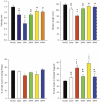The impact of different types of assistive devices on gait measures and safety in Huntington's disease
- PMID: 22363511
- PMCID: PMC3281896
- DOI: 10.1371/journal.pone.0030903
The impact of different types of assistive devices on gait measures and safety in Huntington's disease
Abstract
Background: Gait and balance impairments lead to frequent falls and injuries in individuals with Huntington's disease (HD). Assistive devices (ADs) such as canes and walkers are often prescribed to prevent falls, but their efficacy is unknown. We systematically examined the effects of different types of ADs on quantitative gait measures during walking in a straight path and around obstacles.
Methods: Spatial and temporal gait parameters were measured in 21 subjects with HD as they walked across a GAITRite walkway under 7 conditions (i.e., using no AD and 6 commonly prescribed ADs: a cane, a weighted cane, a standard walker, and a 2, 3 or 4 wheeled walker). Subjects also were timed and observed for number of stumbles and falls while walking around two obstacles in a figure-of-eight pattern.
Results: Gait measure variability (i.e., coefficient of variation), an indicator of fall risk, was consistently better when using the 4WW compared to other ADs. Subjects also walked the fastest and had the fewest number of stumbles and falls when using the 4WW in the figure-of-eight course. Subjects walked significantly slower using ADs compared to no AD both across the GAITRite and in the figure-of-eight. Measures reflecting gait stability and safety improved with the 4WW but were made worse by some other ADs.
Conflict of interest statement
Figures




Similar articles
-
Assistive devices alter gait patterns in Parkinson disease: advantages of the four-wheeled walker.Gait Posture. 2013 May;38(1):20-4. doi: 10.1016/j.gaitpost.2012.10.027. Epub 2012 Dec 11. Gait Posture. 2013. PMID: 23237981 Clinical Trial.
-
Effect of Learning to Use a Mobility Aid on Gait and Cognitive Demands in People with Mild to Moderate Alzheimer's Disease: Part II - 4-Wheeled Walker.J Alzheimers Dis. 2019;71(s1):S115-S124. doi: 10.3233/JAD-181170. J Alzheimers Dis. 2019. PMID: 31127767 Free PMC article.
-
Immediate effects of treadmill walking in individuals with Lewy body dementia and Huntington's disease.Gait Posture. 2021 May;86:186-191. doi: 10.1016/j.gaitpost.2021.03.016. Epub 2021 Mar 8. Gait Posture. 2021. PMID: 33756407 Clinical Trial.
-
[Locomotion disturbances in Huntington's disease].Rev Neurol (Paris). 2010 Feb;166(2):213-20. doi: 10.1016/j.neurol.2009.05.013. Epub 2009 Jul 14. Rev Neurol (Paris). 2010. PMID: 19604530 Review. French.
-
Ambulatory assistive devices in orthopaedics: uses and modifications.J Am Acad Orthop Surg. 2010 Jan;18(1):41-50. doi: 10.5435/00124635-201001000-00006. J Am Acad Orthop Surg. 2010. PMID: 20044491 Review.
Cited by
-
Are older people putting themselves at risk when using their walking frames?BMC Geriatr. 2020 Mar 4;20(1):90. doi: 10.1186/s12877-020-1450-2. BMC Geriatr. 2020. PMID: 32131743 Free PMC article.
-
Assessment of forearm and plantar foot load in the elderly using a four-wheeled walker with armrest and the effect of armrest height.Clin Interv Aging. 2014 Oct 14;9:1759-65. doi: 10.2147/CIA.S70722. eCollection 2014. Clin Interv Aging. 2014. PMID: 25342894 Free PMC article.
-
Cognitive and Physical Intervention in Metals' Dysfunction and Neurodegeneration.Brain Sci. 2022 Mar 3;12(3):345. doi: 10.3390/brainsci12030345. Brain Sci. 2022. PMID: 35326301 Free PMC article. Review.
-
Reduced brainstem volume is associated with mobility impairments in youth with cerebral palsy.J Clin Neurosci. 2023 Nov;117:114-119. doi: 10.1016/j.jocn.2023.09.025. Epub 2023 Oct 4. J Clin Neurosci. 2023. PMID: 37801875 Free PMC article.
-
Flexible Piezoelectric Sensor-Based Gait Recognition.Sensors (Basel). 2018 Feb 5;18(2):468. doi: 10.3390/s18020468. Sensors (Basel). 2018. PMID: 29401752 Free PMC article.
References
-
- Verza R, Carvalho ML, Battaglia MA, Uccelli MM. An interdisciplinary approach to evaluating the need for assistive technology reduces equipment abandonment. Mult Scler. 2006;12:88–93. - PubMed
-
- Cubo E, Moore CG, Leurgans S, Goetz CG. Wheeled and standard walkers in Parkinson's disease patients with gait freezing. Parkinsonism Relat Disord. 2003;10:9–14. - PubMed
-
- Hausdorff JM, Mitchell SL, Firtion R, Peng CK, Cudkowicz ME, et al. Altered fractal dynamics of gait: reduced stride-interval correlations with aging and Huntington's disease. Journal of applied physiology. 1997;82:262–269. - PubMed
-
- Hausdorff JM, Cudkowicz ME, Firtion R, Wei JY, Goldberger AL. Gait variability and basal ganglia disorders: stride-to-stride variations of gait cycle timing in Parkinson's disease and Huntington's disease. Mov Disord. 1998;13:428–437. - PubMed
-
- Churchyard AJ, Morris ME, Georgiou N, Chiu E, Cooper R, et al. Gait dysfunction in Huntington's disease: parkinsonism and a disorder of timing. Implications for movement rehabilitation. Advances in neurology. 2001;87:375–385. - PubMed
Publication types
MeSH terms
LinkOut - more resources
Full Text Sources
Medical

